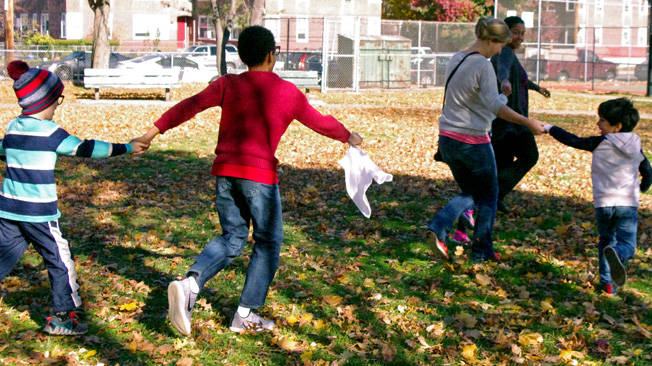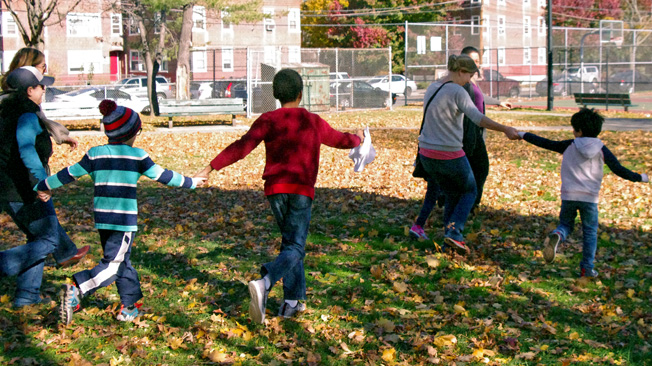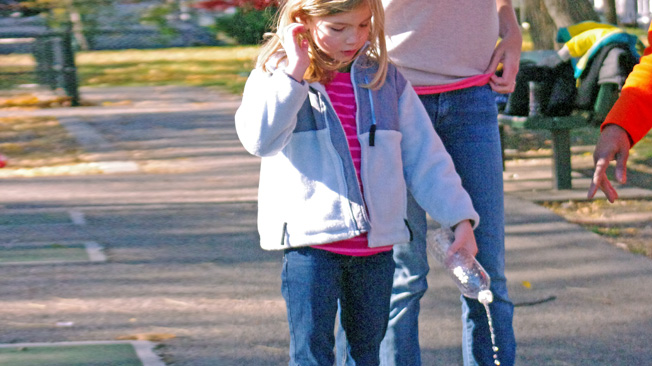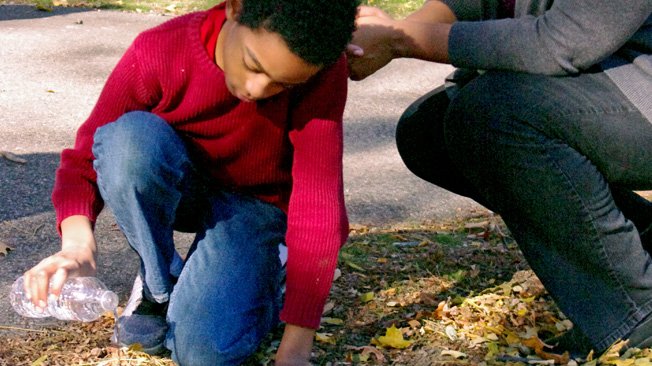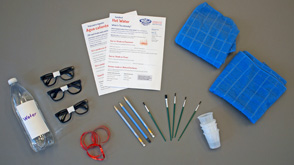Hot Water
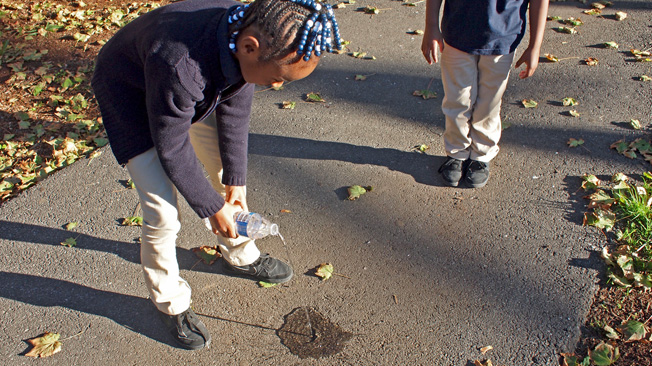
What Is This Activity?
What happens when heat meets water? Families explore how heat causes water to dry up faster, a process called evaporation that can help animals, including humans, cool down.
Introduction
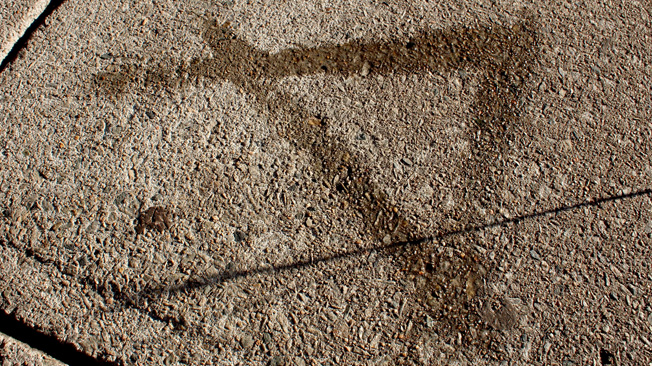
Learning Goals
Big Science Idea:
- When water dries up, or evaporates, it carries away hot air, making things cooler. Heat speeds up that process.
Skills kids will use to investigate it:
Model how the amount of heat energy present determines the temperature
Observe and communicate how evaporation cools things off by removing heat energy
Observe, compare, and measure the temperatures of different surfaces to conclude that heat causes water to evaporate faster
How Do You Get Ready?
Scout out three spaces: one with sunny and shady sections of pavement; one with sunny and shady patches of grass; and one with human-made materials (such as metal fencing and plastic or rubber playground equipment, etc.) near natural materials (such as grass, trees, wood chips, wooden benches, etc.).
Identify and mark each of the three locations with a ribbon so families know where to go next to measure temperature (see handout). At the first location, set out cups of water and paintbrushes.
Troubleshoot any safety concerns (traffic, poison ivy, sharp objects, etc.).
Print out one copy per family of the “Hot Water” handout.
If you don’t plan to show the “Cook an Egg!” video that is paired with this activity on the website, watch it ahead of time and jot down concepts to share with families during the activity.
Warm-up 5–10 minutes
(Science Skills: Model how the amount of heat energy present determines the temperature)
Running Hot and Cold. In this three-way version of Snake’s Tail tag, two teams compete to steal “heat” from a third team.
Put half the group on a “Red Hot” team and give each person a “heat” identifier: Eyeglasses or a red paper circle attached to clothes with a safety pin.
Split the other half into two “Stone Cold” teams. Give the leader of each team a hand towel.
Have each team form a chain by holding hands.
On your signal, the leader of the Red Hot team runs as fast as possible while the two Stone Cold leaders try to tag the last person in the Red Hot chain with the hand towel. Each team’s players must hold hands at all times as they follow their leaders around.
Tagged Red Hot players join the end of the Stone Cold chain that tagged them. They can be tagged again, and stolen, by the other Stone Cold team. The game ends when time is up. The team with the most heat—the most Red Hot players—is the winner. Point out that heat is a form of energy. When something feels hot, it has a lot of heat energy. When it feels cold, it has less heat energy.
Activity 40 minutes
Hot Water
(40 minutes)
(Science Skills: Observe and communicate how evaporation cools things off by removing heat energy; observe, compare, and measure the temperatures of different surfaces)
Did families work up a sweat during the warm-up? If not, have them play another game of “Running Hot and Cold,” with switched roles for the players.
Ask families to blow on their sweaty arm or use their hand to fan their sweaty faces. If there’s a breeze, ask how the wind makes them feel. Explain that when sweat dries up, you feel cooler. Wind makes sweat dry up faster, so you cool off more quickly. When a liquid dries up, that’s called evaporation. Water that evaporates doesn’t disappear. It changes into an invisible gas called water vapor. The water vapor drifts away, taking hot air with it.
Wonder aloud: Does heat make water dry up faster or slower?
For older or more mature children: Wonder aloud whether it’s possible to predict exactly how long it would take a puddle to evaporate. What information about the puddle would you need to know?
Pass out the “Hot Water” handout and review the directions with families.
Give each family a pencil and a thermometer and a copy of the handout. They can use the handout for recording their results.
Divide families into three groups, one for each location. After five minutes, tell groups to rotate to the next location, and then repeat for the third location.
Gather as a group and compare results. Which was the hottest surface you touched or measured? The coolest? (Families might notice a large difference between sun and shade on pavement, less so between sun and shade on grass. Human-made objects might be hotter than natural ones, depending on materials.)
Check the water drawings. Ask: What happened? Were your predictions right? (Water in the sun dries up more quickly than water in the shade.)
Wrap-up 5 minutes
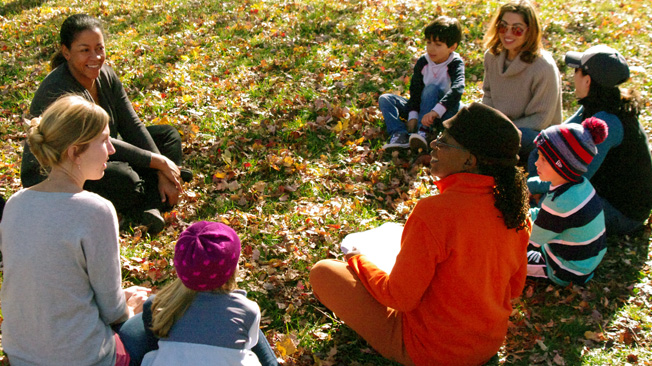
(Science Skills: Use observations and data to conclude that heat causes water to dry up)
Ask: Which location had the biggest difference in temperature? Any surprises?
Discuss: If you wanted water to dry up as fast as possible, what would you do? (Put it on the hottest surface you can find. Heat speeds up evaporation. Kids might also mention wind and spreading the water around as factors.)
Encourage families to take home the “Hot Water” handout to repeat the activity in their neighborhoods and point out the “Explore Some More” activities. If you wish, give them the “Explore Water Around You” and “Explore Weather Around You” handouts to provide them with more ideas on how to continue investigating water and weather together.
Explore Some More
Race for Cover
Have kids race around your outdoor area to see who can find the most spots for animals to find relief from the heat. Remind them that insects, spiders, and other small critters are animals, too—and so are humans! Guiding questions:
- Where can animals go? What might they do to cool off? (Get wet and let the water evaporate; seek shade under trees, bushes, and objects; pant out hot air in their breath; burrow underground, drink from a puddle or a fountain in the park, etc. Besides sweating, people might have an icy drink, go for a swim, turn on air conditioning or a fan, or wear light clothing.)

